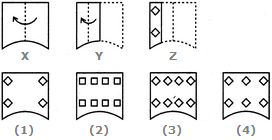Discussion
Home ‣ Non Verbal Reasoning ‣ Pattern Completion See What Others Are Saying!
- Question
Identify the figure that completes the pattern.
 (X) (1) (2) (3) (4)
(X) (1) (2) (3) (4)
Options- A. 1
- B. 2
- C. 3
- D. 4
- Correct Answer
- 4
Explanation
More questions
- 1. Choose a figure which would most closely resemble the unfolded form of Figure (Z).

Options- A. 1
- B. 2
- C. 3
- D. 4 Discuss
Correct Answer: 3
- 2. How many cubes/blocks are there in below figure?
Options- A. 8
- B. 9
- C. 10
- D. 11 Discuss
Correct Answer: 9
Explanation:
Total cubes = 9
- 3. Select the one which is different from the other three responses
Options- A. 1
- B. 2
- C. 3
- D. 4 Discuss
Correct Answer: 4
Explanation:
In all other figures all the three designs face different directions but in figure (4) two of the three designs face the same direction.
- 4.
If a mirror is placed on the line MN, then which is the right image of the given figure?


Options- A. 1
- B. 2
- C. None
- D. 4 Discuss
Correct Answer: 1
Explanation:
- 5.
Select the alternative which represents three out of the five alternative figures which when fitted into each other would form a complete square.

Options- A. 1,3,4
- B. 1,4,5
- C. 1,2,5
- D. 1,2,4 Discuss
Correct Answer: 1,4,5
Explanation:

- 6. Select the one which is different from the other three responses
Options- A. 1
- B. 2
- C. 3
- D. 4 Discuss
Correct Answer: 2
Explanation:
Except in figure (2), in all other figures one line segment intersects one arrow at right angle.
- 7. Select the one which is different from the other three responses
Options- A. 1
- B. 2
- C. 3
- D. 4 Discuss
Correct Answer: 1
Explanation:
Except in figure (1), in all other figures the arrow is pointing clockwise. So , figure ( 1 ) is correct .
- 8. Select the one which is different from the other three responses
Options- A. 1
- B. 2
- C. 3
- D. 4 Discuss
Correct Answer: 3
Explanation:
In figure (3) all circles are concentric. But all other figure are in same .
- 9. In each of the following questions which of the answer figures is exactly the mirror image of the question figure when the mirror is held at the given point
Options- A. .
- B. .
- C. .
- D. . Discuss
Correct Answer: .
Explanation:
Answer A
- 10. How many lines of symmetry does a Pentagon have?
Options- A. 4
- B. 5
- C. 6
- D. 0 Discuss
- The number of lines of symmetry in a regular polygon is equal to the number of sides.
Correct Answer: 5
Explanation:
A regular Pentagon have 5 sides and 5 lines of symmetry.
Comments
There are no comments.
- 1. Choose a figure which would most closely resemble the unfolded form of Figure (Z).
Programming
Copyright ©CuriousTab. All rights reserved.
